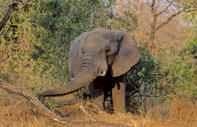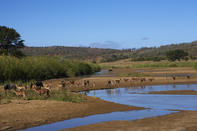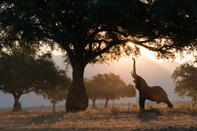Mega Herbivores

Where do elephants fit into climate change? A good question - and it's one that the next generation of computer modelling is expected to answer. Where the Country Studies Report looked at temperature-water-CO-nitrogen interactions, Dr Bob Scholes from the Council for Scientific and Industrial Research (CSIR), believes that the next step is to include elephants into that equation.
They may seem to be messy and wasteful consumers. But Prof. Norman Owen-Smith of the University of the Witwatersrand's Centre for African Ecology says elephants should not be seen in this 'narrow ecological perspective'. Rather, they are as critical in the shaping of savannahs as fire and frost. Every plant-eating animal changes its environment somehow, but when it needs 200 kg of food a day, it takes things to a whole new level. Welcome to the world of the mega-herbivores. Take elephants out of an ecosystem and it will get swamped with trees.
Cycle of Life

Hluhluwe-iMfolozi Park in KwaZulu-Natal lost its elephants in 1870. Owen-Smith explains that fires kept glades open and expansive until grazing animal populations increased. More grazing meant less grass for fire; few fires meant more trees. Before long, trees were crowding in, extending their green canopies over formerly open spaces and creating thickets.
The Kruger National Park saw a progressive loss of big trees following a steady increase in its elephant population as the animals began filtering back into the area from Mozambique after the park was established in the 1960s. The potential loss of habitat for vultures and high-nesting eagles may appear to be problematic.
But elephants also open up the savannah to accommodate a specific suite of species - once they clear away the trees, white rhino mow high grass down to a neat lawn. Shorter grasses then move in, as do the grazers. With their constant eating and excreting, a rich grazing lawn develops. With fire kept out of this system, grazers become the recyclers of nutrients.
And when it comes to recycling nutrients, elephants are at the top of the food chain with their vast appetites. Attractive as they are, trees hold onto their nutrients for the duration of their lives, except for the occasional shedding of fruit and leaves. Take the baobab - a tree with a 10 m diameter girth is probably 2 000 years old.
This means the sapling banked away its first nutrients when Jesus preached the sermon on the mount; the adolescent tree continued when the Prophet Muhammad warned Mecca against the perils of wealth and excess; it was still at it when Ghandi defied British Colonial rule in India, and it is still standing today. That's an impressive record by anyone's measure.
Every time an elephant pushes over a tree or breaks off a branch for a single mouthful of leaves, it is helping to recycle nutrients back through the system again. Like it or not, that's the natural order of things.
Stable State

For a long time, scientists believed that there were only two possible stable states in the interaction between elephants and savannahs: grassland that is virtually denuded of trees or a woodland state.
Now the thinking suggests that a third possible stable state lies somewhere in between the two - shrubby hedges where trees are pruned back by the foraging animals, allowing them to coppice into smaller, bushier shrubs. Stunted trees like this offer leaves to any browser shorter than a giraffe, meaning there's a little more to go around for the average Joe of the bushveld.
This next step in computer modelling will help to explain how temperature, rainfall, seasonality, CO, soil texture, fire and mega-herbivores might shape savannahs in a changing climate.
It is already being suspected that the effects of decreased water and increased temperature will negate any CO fertilisation; that large numbers of elephant in a savannah will maintain a stable coppice state; and that ultimately habitat alteration in a changing climate will depend on how fires and elephants are managed.